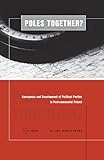Poles Together? : The Emergence and Development of Political Parties in Postcommunist Poland / Aleks Szczerbiak.
Material type: TextPublisher: Budapest ; New York : Central European University Press, [2001]Copyright date: ©2001Description: 1 online resource (300 p.)Content type:
TextPublisher: Budapest ; New York : Central European University Press, [2001]Copyright date: ©2001Description: 1 online resource (300 p.)Content type: - 9789633864630
- 324.2438 21
- JN6769.A45S78 2001
- online - DeGruyter
| Item type | Current library | Call number | URL | Status | Notes | Barcode | |
|---|---|---|---|---|---|---|---|
 eBook
eBook
|
Biblioteca "Angelicum" Pont. Univ. S.Tommaso d'Aquino Nuvola online | online - DeGruyter (Browse shelf(Opens below)) | Online access | Not for loan (Accesso limitato) | Accesso per gli utenti autorizzati / Access for authorized users | (dgr)9789633864630 |
Frontmatter -- TABLE OF CONTENTS -- LIST OF TABLES -- PREFACE AND ACKNOWLEDGMENTS -- LIST OF ABBREVIATIONS -- Chapter One: Introduction -- Chapter Two: The Distribution of Power within Parties -- Chapter Three: The Party Machine -- Chapter Four: Parties and Their Electorates -- Chapter Five: Parties as Membership Organizations -- Chapter Six: Parties and the State -- Chapter Seven: Conclusion -- Appendix 1 : Parties and Organizations in the Democratic Left Alliance, May 1997 -- Appendix 2: Parties and Organizations in Solidarity Electoral Action, March 1997 -- Bibliography -- Index
restricted access online access with authorization star
http://purl.org/coar/access_right/c_16ec
This book fills a gap in the existing literature on how parties and party systems are developing in the new democracies of post-communist Central and Eastern Europe. It provides the first detailed, empirically based examination from a structural and organizational perspective of the new parties and political groupings that have emerged in Poland since the collapse of communism in 1989. The author develops his argument on the basis of an analysis of five key structural and organizational variables: the internal distribution of power and modes of representation within the parties; the role of the party bureaucracy; the relationship between parties and their electorates; the development of parties as membership organizations; and the relationship between parties and the state. As the first in-depth, empirically grounded single-country study of party structure and organization in post-communist Eastern Europe, the book provides an opportunity to draw broader conclusions about the process of Central and East European party development and will contribute significantly towards the development of a post-communist political party model. Szczerbiak sheds light on an important aspect of the more general process of post-communist democratization in the region and provides a major contribution to one of the least-explored areas of transition.
Mode of access: Internet via World Wide Web.
In English.
Description based on online resource; title from PDF title page (publisher's Web site, viewed 28. Mrz 2023)


